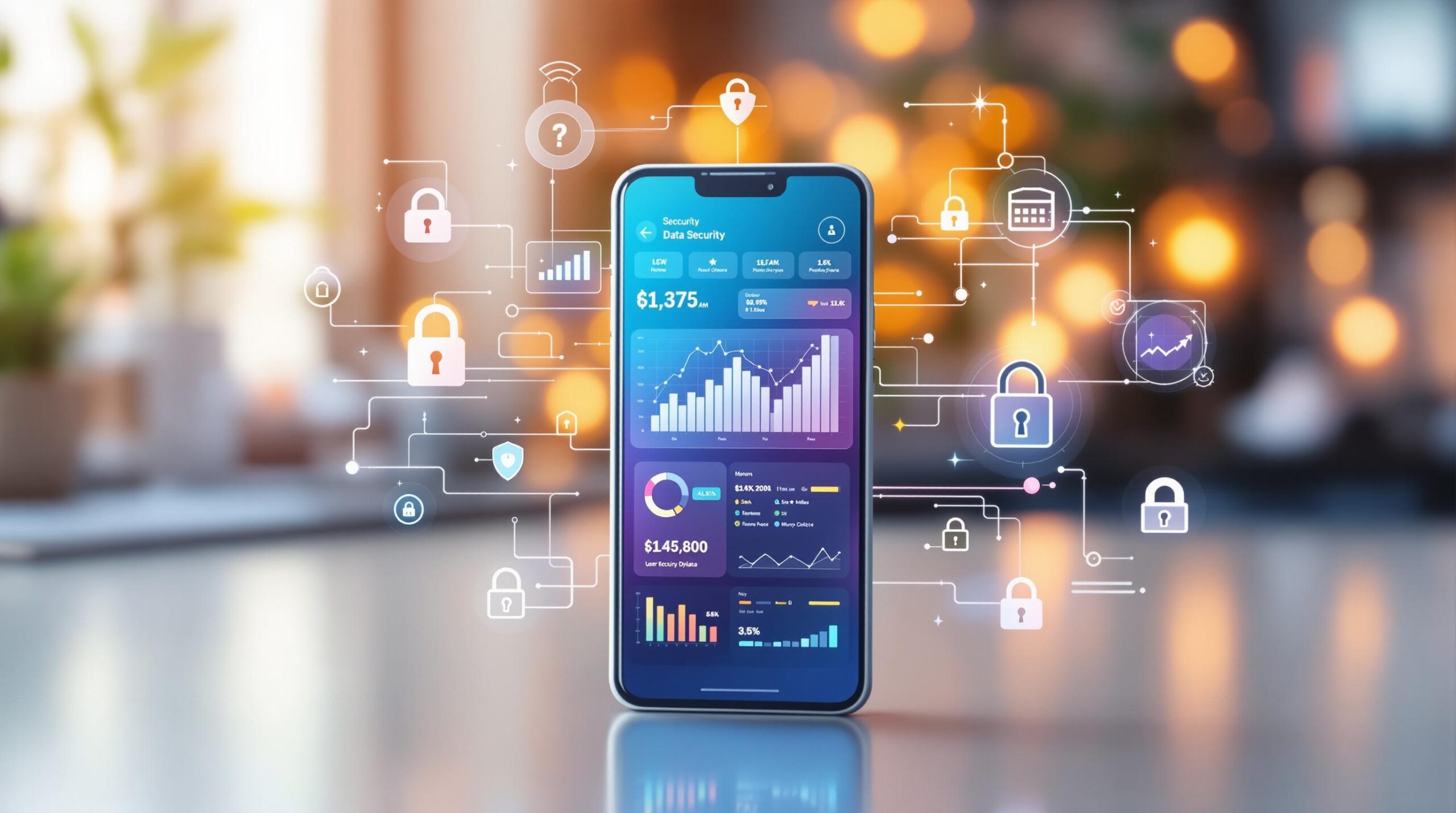
Mobile apps are under attack like never before. With cybercrime costs expected to exceed $23 trillion annually by 2027, securing apps is no longer optional. Over 75% of mobile apps have security flaws, and phishing attacks have surged by 4,151% since AI tools emerged. Here’s what you need to know:
- Top Threats in 2025: AI-driven malware, Ransomware-as-a-Service (RaaS), and IoT vulnerabilities are reshaping the security landscape.
- Key Solutions: Post-quantum cryptography, AI-powered security systems, and robust encryption are essential to combat these risks.
- User Demands: 81% of users worry about data handling, pushing businesses toward privacy-first app designs with features like biometric authentication and transparent data practices.
- Regulatory Pressure: Fines under GDPR can reach €20M, making compliance a critical priority.
To protect your apps and user data, adopt strong security testing, integrate blockchain for tamper-proof storage, and implement hardware-level safeguards. Privacy-focused principles and advanced defenses will not just meet regulations but also build trust with your users.
Mastering Mobile App Security: Essential Best Practices to Protect Your Data and Privacy
Challenges in Mobile App Data Security for 2025
As technology advances, protecting user data in mobile apps is becoming increasingly complex. Developers and businesses face a growing number of challenges in securing their apps against ever-evolving threats.
Emerging Threats in Mobile App Security
New types of attacks, like AI-driven malware and Ransomware-as-a-Service (RaaS), are reshaping the security landscape. AI can now imitate legitimate behavior, making it harder to detect malicious activities. Meanwhile, platforms like LockBit 3.0 make launching ransomware attacks more accessible. These developments call for smarter behavioral analysis tools and frequent security updates. For context, credential phishing attacks have surged by 703%, showing just how critical this issue has become [1]. Additionally, the rise of IoT devices has widened the attack surface, adding new challenges in securing connected systems.
| Threat Type | Impact | Mitigation Challenge |
|---|---|---|
| AI-Driven Malware | Mimics legitimate behavior | Requires advanced behavioral tools |
| RaaS Platforms | Easier attack deployment | Demands constant security updates |
| IoT Vulnerabilities | Expands attack surface | Needs robust device authentication |
Stricter Regulations and Compliance
New laws like the EU’s Cyber Resilience Act, along with updates to GDPR and CCPA, have made compliance more demanding. With GDPR fines reaching up to €20 million or 4% of global revenue, businesses must now integrate privacy-focused practices into every stage of app development. Meeting these legal demands is no longer optional – it’s a central part of app security.
Rising User Privacy Demands
Users today expect more control and transparency regarding their personal data. This shift is happening alongside alarming statistics, such as 98% of employers recognizing that their employees are still vulnerable to phishing and social engineering attacks [1]. Developers are under pressure to clearly communicate security measures and offer features like device-based authentication, which is quickly replacing SMS OTPs as a safer and more user-friendly option.
The growing trend of direct-to-consumer app distribution adds another layer of complexity to traditional security models. To keep up, businesses must rethink their strategies and embrace advanced technologies. Future solutions like AI-driven security systems and post-quantum cryptography will play a crucial role in addressing these challenges, as we’ll explore in the next section.
Strategies for Securing Mobile Apps
As mobile security challenges continue to grow, staying ahead requires a mix of advanced techniques and proactive measures. Here are three crucial strategies for safeguarding user data in mobile apps.
Post-Quantum Cryptography
Post-quantum cryptography is designed to protect against potential risks posed by quantum computing. By using methods like lattice-based and hash-based algorithms, this approach shields apps from quantum threats. Companies such as Google are already exploring these solutions [1]. A hybrid model that blends traditional encryption with post-quantum techniques ensures compatibility with current systems while preparing for future risks – all without sacrificing performance.
AI-Driven Security Systems
AI plays a key role in strengthening app security by identifying and addressing threats as they happen. Features like behavioral analysis, real-time monitoring, and predictive defense allow AI systems to spot anomalies, such as suspicious app activity or unauthorized network access, and respond immediately. This proactive approach helps block new attack methods before they can cause harm [3].
Encryption and Secure Data Storage
Encryption is a must for protecting data both in transit and at rest. Tools like OpenSSL offer strong frameworks for safeguarding sensitive information [3]. Additionally, solutions like IPification replace traditional passwords with secure Mobile IDs, leveraging device and network data for authentication [1]. Key measures for enhancing data security include:
- Server-side attestation to enable secure remote decisions [4]
- Dynamic attestation models that adapt to evolving threats [4]
- Secure key management to maintain encryption reliability [3]
Bringing these strategies together creates a robust security framework capable of addressing today’s threats while preparing for those on the horizon. By combining post-quantum cryptography, AI-powered defenses, and solid encryption practices, mobile apps can deliver the protection users need. Incorporating privacy-focused principles alongside these measures ensures user trust and a balanced approach to data security.
sbb-itb-7af2948
Privacy-Focused App Design
Designing apps with privacy in mind not only strengthens user trust but also helps meet regulatory requirements. It’s all about combining strong security features with clear, user-friendly data practices that let people control their information.
Privacy by Design Principles
Privacy by Design (PbD) is all about integrating data protection into an app from the very start. The Cisco 2024 Data Privacy Benchmark Study found that 80% of businesses saw a boost in customer loyalty after focusing on privacy measures.
Key elements of PbD include limiting data collection, enabling default privacy settings, and performing regular impact assessments.
"Privacy by Design enables businesses to build data protection practices into product offerings." – Usercentrics
While PbD sets the stage for secure apps, advanced authentication methods take it a step further by improving both security and user confidence.
Advanced Authentication Methods
Authentication has come a long way from traditional passwords, offering safer and more user-friendly options. For example, the global market for biometric authentication has been growing at 15% annually since 2019.
| Authentication Method | Security Level | User Experience | Implementation Complexity |
|---|---|---|---|
| Biometric (Face/Fingerprint) | High | Excellent | Medium |
| Multi-Factor (MFA) | Very High | Good | High |
| Zero-Trust Framework | Maximum | Moderate | Complex |
One standout example is IPification, which uses device, SIM card, and network data to create secure Mobile ID keys, removing the risks associated with traditional passwords [1].
Clear Data Practices
Being upfront about data practices is key to earning user trust and staying compliant. A Pew Research report shows that 81% of U.S. adults are concerned about how companies handle their data.
Transparent Privacy Controls
- Clear, easy-to-understand consent options for data collection
- Straightforward ways for users to opt out
User Data Management
- Portals that let users access their own data
- Clear policies for how long data is kept
- Automatic options for deleting data
The CNIL advises that mobile apps should focus on privacy by limiting data collection and giving users control over how their data is used [2].
Securing Mobile Apps Against Future Threats
Protecting mobile apps from evolving threats means employing rigorous testing, incorporating blockchain technology, and integrating hardware-level security measures.
Regular Security Testing and Managing Vulnerabilities
As cyber threats become more advanced, frequent security testing is essential to identify and fix weak points before they can be exploited. Guardsquare reports that 71% of companies face challenges due to a lack of security expertise, emphasizing the importance of structured testing systems [4].
Effective strategies include automated scans, penetration testing, and compliance checks. These not only address vulnerabilities but also ensure adherence to regulations. For example, AppSealing uses AI-based testing to detect threats with precision while maintaining app performance. Their system continuously monitors for risks, ensuring vulnerabilities are addressed promptly.
In addition to testing, new technologies like blockchain are reshaping how apps secure data and maintain integrity.
Blockchain for Securing Data
Blockchain technology offers tamper-proof data storage, making it especially valuable in areas like healthcare and finance. Its projected growth from $4.8 billion in 2022 to $2.3 trillion by 2032 underscores its expanding role in security.
Here’s how blockchain is being used:
- Healthcare apps: Protect patient records and treatment plans with secure storage.
- Financial platforms: Automate secure transactions using smart contracts.
- Identity systems: Enhance verification processes with immutable data storage.
By ensuring data cannot be altered, blockchain provides a strong foundation for secure app ecosystems.
Hardware-Level Security in App Design
Trusted Execution Environments (TEEs) bring advanced security to mobile apps. Operating alongside Android, TEEs isolate sensitive tasks, preventing threats like keylogging, screen recording, and unauthorized access.
A good example is Trustonic‘s TAP 2.0 SDK, which includes:
- Cryptographic tools for secure data handling.
- Device and app verification features.
- Protection for sensitive operations.
Collaboration between companies like Huawei and Trustonic has expanded opportunities for developers, enabling them to integrate hardware security while safeguarding user privacy.
Another example is Cryptomathic’s Mobile App Security Core (MASC), which combines multiple security layers. It offers real-time monitoring, detects suspicious activities, and ensures secure communication between apps and servers.
Combining advanced hardware security with intelligent software solutions ensures mobile apps are better equipped to handle the threats of tomorrow.
Conclusion: Protecting User Privacy in 2025 and Beyond
Staying Ahead of Threats
The mobile app security landscape is changing fast, with cybercrime costs expected to surpass $23 trillion annually by 2027 [1]. As threats grow more advanced, organizations need to take action to secure their apps. These efforts are crucial to counter AI-driven malware and RaaS threats, ensuring apps stay protected in an ever-evolving digital environment.
Building Trust Through Privacy
Privacy is no longer optional – it’s what users expect. A recent survey found that 72% of Americans support stronger privacy regulations. Designing apps with privacy in mind not only ensures compliance but also earns long-term user trust. Gartner forecasts that by 2025, more than 60% of large businesses will implement privacy-focused technologies, reflecting this growing demand.
Here’s a quick look at common privacy concerns and their effects:
| Privacy Concern | Impact on Users | Business Implication |
|---|---|---|
| Data Collection | 76% worry about unauthorized data use | Calls for clearer and ethical practices |
| Sensitive Data Handling | Over 80% concerned about healthcare and child data | Stronger safeguards are needed |
As user expectations rise, developers and decision-makers must take clear, effective steps to address these challenges.
Steps for Developers and Leaders
With more than 75% of apps containing at least one security flaw, a layered approach to security is more important than ever.
"Secure coding practices are essential from the start", stress security experts, underscoring the need to embed security into every stage of development.
Key priorities for organizations include:
- Leveraging AI for real-time threat detection
- Implementing post-quantum cryptography to prepare for future risks
- Conducting regular and thorough security audits
Moving forward, staying alert to new threats while fostering trust through transparent privacy measures and strong security practices will be crucial.

